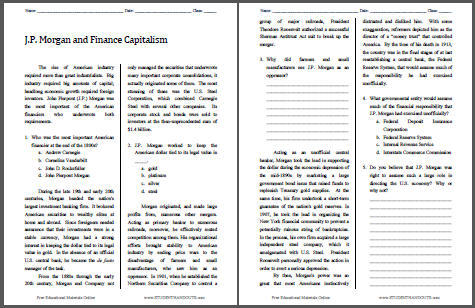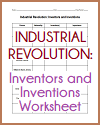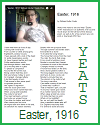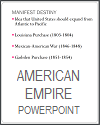J.P. Morgan and Finance Capitalism |
 The rise of American industry required more than great
industrialists. Big industry required big amounts of
capital; headlong economic growth required foreign investors.
John Pierpont (J.P.) Morgan was the most important of the
American financiers who underwrote both requirements. The rise of American industry required more than great
industrialists. Big industry required big amounts of
capital; headlong economic growth required foreign investors.
John Pierpont (J.P.) Morgan was the most important of the
American financiers who underwrote both requirements.During the late 19th and early 20th centuries, Morgan headed the nation's largest investment banking firm. It brokered American securities to wealthy elites at home and abroad. Since foreigners needed assurance that their investments were in a stable currency, Morgan had a strong interest in keeping the dollar tied to its legal value in gold. In the absence of an official U.S. central bank, he became the de facto manager of the task. From the 1880s through the early 20th century, Morgan and Company not only managed the securities that underwrote many important corporate consolidations, it actually originated some of them. The most stunning of these was the U.S. Steel Corporation, which combined Carnegie Steel with several other companies. Its corporate stock and bonds were sold to investors at the then-unprecedented sum of $1.4 billion. Morgan originated, and made large profits from, numerous other mergers. Acting as primary banker to numerous railroads, moreover, he effectively muted competition among them. His organizational efforts brought stability to American industry by ending price wars to the disadvantage of farmers and small manufacturers, who saw him as an oppressor. In 1901, when he established the Northern Securities Company to control a group of major railroads, President Theodore Roosevelt authorized a successful Sherman Antitrust Act suit to break up the merger. Acting as an unofficial central banker, Morgan took the lead in supporting the dollar during the economic depression of the mid-1890s by marketing a large government bond issue that raised funds to replenish Treasury gold supplies. At the same time, his firm undertook a short-term guarantee of the nation's gold reserves. In 1907, he took the lead in organizing the New York financial community to prevent a potentially ruinous string of bankruptcies. In the process, his own firm acquired a large independent steel company, which it amalgamated with U.S. Steel. President Roosevelt personally approved the action in order to avert a serious depression. By then, Morgan's power was so great that most Americans instinctively distrusted and disliked him. With some exaggeration, reformers depicted him as the director of a “money trust” that controlled America. By the time of his death in 1913, the country was in the final stages of at last reestablishing a central bank, the Federal Reserve System, that would assume much of the responsibility he had exercised unofficially. |
| Click here to print. Answer Key: (1) D - John Pierpont Morgan; (2) A - gold; (3) He ended price wars to their disadvantage; (4) B - Federal Reserve System; (5) Answers will vary. |
 |
|---|
Text courtesy of the U.S. State Department, Bureau of International Information Programs, 2005 |










